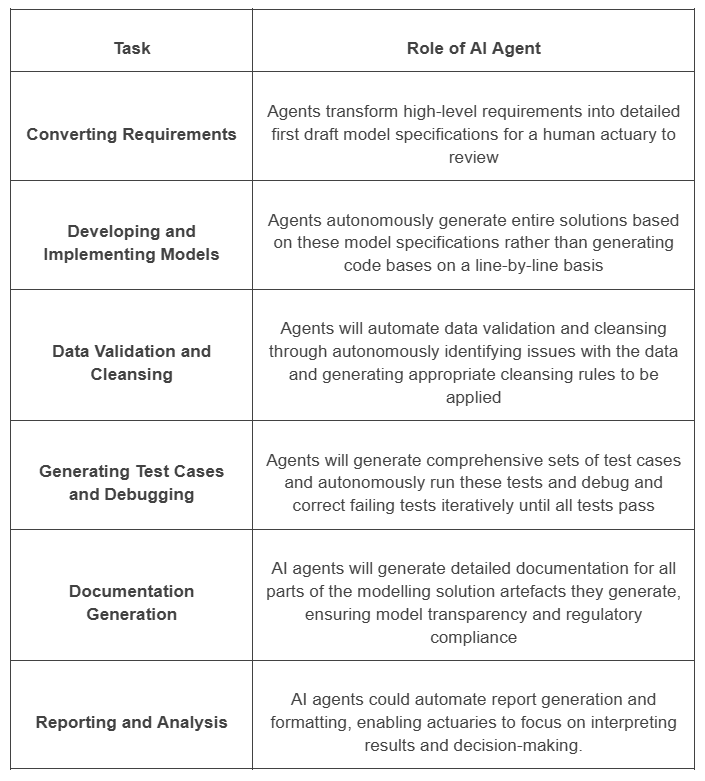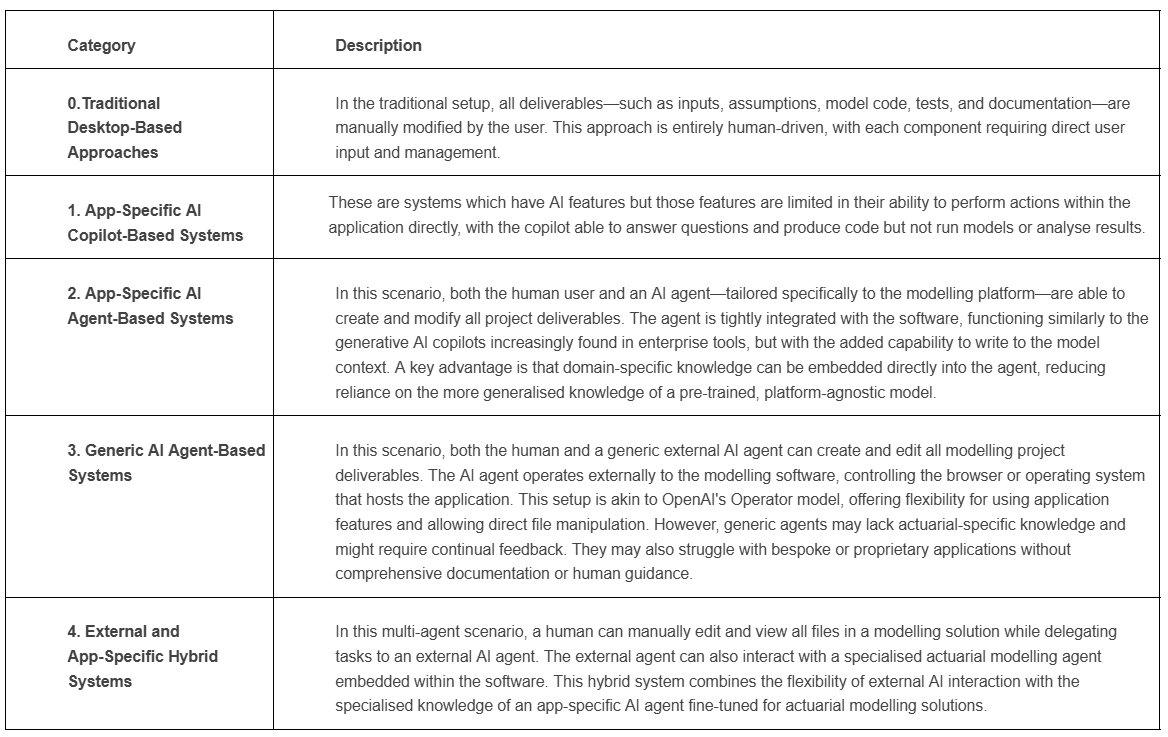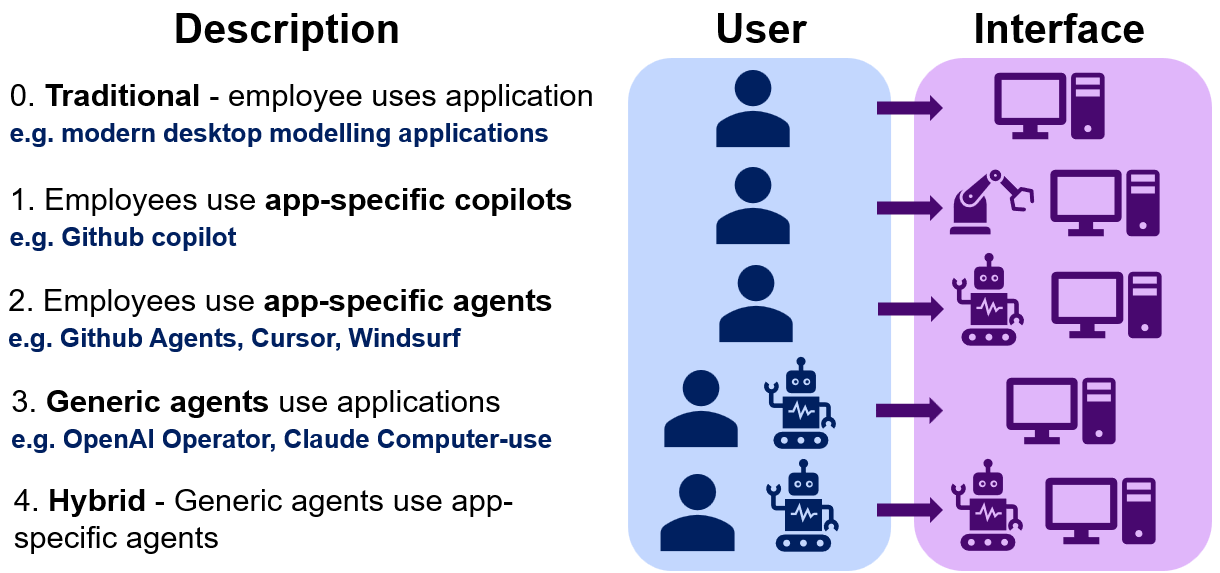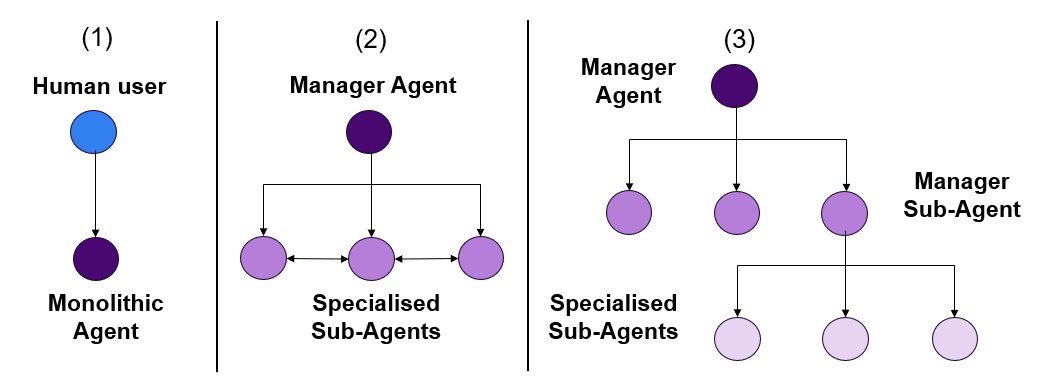Actuarial Modelling in the Age of AI Agents
How actuarial modelling will be transformed over the coming decade
This article is the second in a series on the topic of AI agents within actuarial work. To read the first part in the series follow this link: https://ifoagenai.substack.com/p/ai-agents-or-how-i-learned-to-stop
1. Introduction
The emergence of AI agents is set to transform actuarial modelling, presenting unprecedented opportunities to boost productivity throughout every stage of the modelling process. This paper explores the transformative potential of AI agents in actuarial modelling, examining their current applications and considering the far-reaching implications for the future of the actuarial profession. We assess the ways in which AI agents can support the writing, testing, debugging, and documentation of models, and discuss how the dynamics of human-model interaction may evolve in an AI-assisted environment. Furthermore, we draw parallels between the impact of AI agents in software development and their anticipated influence in actuarial modelling, positioning recent advances in software automation as a bellwether for the future trajectory of AI-driven automation in the actuarial field.
2. Actuarial Modelling and Software Development Processes: Two Sides of the Same Coin
The actuarial modelling lifecycle shares many similarities with the software development lifecycle. Understanding parallels and divergences between these two processes is essential to appreciate how advancements in software engineering AI agents could soon be mirrored in actuarial work. In tables 2.1 and 2.2 below we summarise the similarities and differences between actuarial modelling lifecycle and the software development lifecycle. As these tables make evident, actuarial modelling can be thought of as a highly specialised instance of software development.
Table 2.1: Similarities Between the Different Stages within the Actuarial Modelling and Software Development Lifecycles.
Table 2.2. Differences Between Actuarial Modelling and Software Development.
This evidence of accelerating AI adoption in software engineering provides a valuable lens through which to consider the likely trajectory of actuarial modelling over the coming decade. Indeed, actuarial modelling can be seen as a specialised branch of software development, sharing core principles of algorithm design, data manipulation, and automation—though tailored to domain-specific requirements. Innovations in modelling tools and automation have tended to emerge first in mainstream software development, with actuarial practice often adopting these advances with a noticeable lag, sometimes as much as a decade later. Figure 2 illustrates this close relationship, highlighting parallel evolutionary paths, while also showing how advancements in general software development frequently precede those in actuarial modelling. As autonomous AI agents increasingly shift the focus in software from manual coding to orchestration and high-level system management, we should expect comparable transformative effects in actuarial modelling. Actuaries are thus likely to benefit from the productivity and quality gains pioneered by their counterparts in software engineering, as AI agents become more deeply embedded in actuarial workflows. However, the pace of this change may well surpass that of previous adoption cycles, underscoring the importance for actuarial professionals to proactively engage with emerging technologies.
Figure 2. Actuarial modelling is typically 10 or more years behind software engineering practices. Improvements in the capabilities of AI agents in the context of software development will soon have influence on how actuaries develop models.
3. The Impact of Generative AI on Software Development
GenAI is rapidly transforming the software development industry, altering how developers write code, debug, and maintain software. Through leveraging powerful AI models like GitHub Copilot, ChatGPT, and other GenAI coding assistants, software development processes are becoming materially more efficient and less time-consuming.
According to research conducted by GitHub (Github 2022), developers using Github Copilot reported higher job satisfaction, reduced frustration, and an increased ability to focus on more satisfying tasks. Specifically, between 60% of users felt more fulfilled in their roles, 96% reported that Copilot helped them complete repetitive tasks faster, and 87% stated it conserved their mental effort during repetitive tasks. Additionally, in controlled experiments, developers using GitHub Copilot completed tasks 55% faster on average compared to those who did not use the tool, with a success rate of 78% versus 70%. Indeed, several other studies have reported similar findings in regards to the productivity gains achieved with LLM-based tools (see Table 3).
Figure 3: Summary of the Impact of GitHub Copilot on Developer Productivity. Source Microsoft Research (2023).
Table 3: Summary of Key Studies on LLM Impact on Developer Productivity.
These productivity gains are impressive, but it is important to note that LLMs have improved substantially in terms of coding ability since the publication of the results of these studies. Hence we can only conclude that the gains are likely far higher at the time of writing (May 2025).
Building on these early advances, the trajectory of AI in software engineering has progressed from simple code-suggestion copilots to fully agentic systems capable of managing complex development workflows—exemplified by emerging agentic IDEs like Windsurf and Cursor.. As outlined in Part 1, one of the best indicators of this evolution is the SWE-bench benchmark, which tests how well AI can autonomously resolve real-world software issues. When SWE-bench was first deployed, general-purpose models such as ChatGPT 3.5 could solve only about 0.4% of these tasks—underscoring the clear limitations of even impressive early LLMs for full-cycle engineering.
Since then, agentic architectures employing explicit multi-step planning, tool-use and reasoning have brought rapid advances. OpenAI’s o3 model, released in December 2024, surpasses a 70% verified solution rate on SWE-bench and is approaching superhuman-level proficiency, with leaderboard performance now flattening as the benchmark reaches saturation. This jump, observable in less than one year, evidences not only the extraordinary pace of capability growth, but a fundamental transformation in how software will be built, tested, and maintained.
This revolution is visible in a wave of tools moving far beyond simple code completion:
GitHub TestPilot (GitHub Next, 2025a) can automatically generate comprehensive unit tests, radically accelerating the quality assurance cycle.
GitHub Copilot for Pull Requests (GitHub Next, 2025b) leverages AI to draft detailed explanations and commentary when merging code, streamlining the process and improving documentation and auditability.
SpecLang (GitHub Next, 2025c), an experimental tool, empowers developers to author and refine applications through structured natural language specifications, with the agent autonomously generating and updating executable code as requirements change.
The rise of such agentic support is fundamentally changing the division of labour in software engineering. Rather than focusing on rote implementation and manual debugging, developers are freed to concentrate on creative design, system architecture, and higher-order problem solving, while agents handle the scaffolding, testing, and documentation. This shift is not just about speeding up coding; it is a redefinition of the role of software developer.
The rapid progress chronicled in evolving benchmarks like SWE-bench—now nearly saturated for some leading models—shows that the discipline is at a critical inflection point. A corresponding transformation in actuarial modelling is likely only a few years behind. As discussed previously, the structure of actuarial model development closely mirrors that of software engineering: model specification, implementation, testing, documentation, and reporting (see Table 2.1). The very same principles and agentic tools revolutionising coding are poised to automate large portions of the actuarial process as well.
4. Automating Actuarial Modelling Tasks with AI Agents
We should therefore anticipate that actuaries, just like software developers, will soon shift toward oversight, high-level specification, model governance, and strategic innovation. Routine or repetitive processes—data ingestion, formula translation, regression testing, and documentation—will increasingly fall to AI agents designed for the actuarial domain. AI agents will become embedded in various aspects of the modelling process beyond code generation, enabling actuaries to focus on more complex and value-added tasks. Table 4 below outlines how specific tasks within the actuarial modelling process could evolve in this new AI-augmented environment.
Table 4: Deployment of AI Agents within the actuarial modelling life cycle.
AI agents will not only be capable of performing various modeling tasks, but they are also likely to do so with greater reliability and quality. This is because AI can be instructed to ensure that the actuarial model artefacts they generate are always maintainable and fully comply with necessary best practices and regulatory standards. AI may achieve a level of consistency and precision that surpasses human actuaries, who, constrained by time pressures or inattention, may sometimes be forced to or inadvertently cut corners.
5. The Future of Human-Computer Interaction in Actuarial Modelling
5.1. Models of Human and Agent Engagement with Applications
Human-Computer Interaction (HCI) encompasses the ways in which humans engage with computers and software, as well as the design of systems that support and enhance these interactions. As AI agents become increasingly embedded in actuarial modelling, the dynamics of this interaction are set to undergo substantial transformation. In this context, we examine four potential scenarios outlining how actuaries’ engagement with their models may evolve beyond the conventional desktop-based approach.
Table 5.1: Emerging Models of Human and Agent Engagement with Applications.
Figure 5.1: Summary of Emerging Models of Human and Agent Engagement with Applications.
Ultimately, these emerging models signal a profound transformation in how we interact with computers in our professional lives. As AI agents assume a growing share of day-to-day modelling and analysis tasks, the traditional role of the actuary as a "doer" will evolve towards that of a reviewer or overseer—where the primary responsibility shifts from constructing models manually to validating outputs and exercising final judgement. For analysts, whose roles often involve repetitive, structured work, this will be particularly impactful, as many of their core activities stand to be delegated to AI agents. In contrast, senior professionals, who focus more on interpreting management information, strategic decision making, and exception-based oversight, will see comparatively less change in their day-to-day function in the near term. This emerging paradigm will fundamentally reshape our relationship with workplace technology, pushing more routine tasks toward automation and placing a premium on human expertise in supervision, critical review, and decision-making.
5.2. Architectures of agentic systems
Another important consideration in the design of app-specific agent scenarios is the architecture of AI agents within a modeling solution. Broadly, such architectures can be categorised as: monolithic, agent-orchestrated multi-agent systems, or hierarchical multi-agent systems.
In a monolithic system, a single agent is responsible for all aspects of planning and tool use required to fulfil a task, see Figure 5.2.1.
In contrast, an agent-orchestrated multi-agent system comprises several specialised agents, each focused on a particular task or domain. In an actuarial multi-agent system, each individual sub-agent might be dedicated to one specific task within the modelling lifecycle like coding, testing or documenting. These agents operate largely independently and typically require initiation or prompting from a human modeller to perform tasks.
Alternatively, a hierarchical multi-agent system features a lead agent that oversees the overall process and delegates specific responsibilities to various sub-agents. These sub-agents may themselves delegate tasks to more specialised child agents, resulting in a multi-layered, scalable structure for task management. For instance, in an actuarial hierarchical system, a top-level agent could coordinate the entire modelling workflow, while a Manager sub-agent might assign tasks like code writing and code review to lower-level child agents.
Figure 5.2.1. A monolithic agent (or individual nodes within a multi-agent) system can have its own capacity for planning, memory and tool use.
Figure 5.2.2. (1) Monolithic System (2) Human Orchestrated Multi-Agent System (3) Hierarchical Agent-Orchestrated Systems.
This spectrum of agent architectures offers varying degrees of specialisation, autonomy, and scalability, each bringing distinct advantages depending on the specific requirements of a solution. Monolithic agents are simpler to architect and would likely serve as the first iteration of an agentic system. However, multi-agent systems provide important benefits: they can be more token-efficient, thereby reducing compute costs, and they distribute responsibilities among agents, lowering cognitive load and improving reliability. When a single agent is tasked with too many responsibilities, its attention mechanisms can become overwhelmed, which may compromise performance. By dividing tasks, multi-agent and hierarchical systems help ensure more stable and effective operation. A further advantage of multi-agent approaches is their ability to operate asynchronously and in parallel, significantly boosting efficiency and speed. Modern frameworks such as LangGraph (2025) and CrewAI (2025) now make the development of such sophisticated multi-agent systems increasingly accessible.
It is important to note, however, that the adoption of these AI-driven architectures does not necessarily eliminate the role of the human modeller. All artifacts generated by the AI agents can remain accessible for review and modification by humans. Moreover, the agents should ideally be designed so their reasoning and modeling choices are clearly documented within logs or accompanying documentation to ensure transparency within the process.
It is possible that the architecture of human–agent interaction will gradually evolve through various stages over the coming years. Alternatively, a single paradigm may emerge as the dominant approach, depending on how the field develops. Much of this evolution will be closely tied to advances in the intelligence and reliability of AI systems.
As AI becomes more capable and trustworthy, it will be feasible to delegate increasingly abstract tasks and higher-level control to AI agents—moving beyond the current state, where significant scaffolding and human oversight are required to ensure sufficient accuracy and reliability. It is anticipated that the range of tasks assigned to AI agents will continue to expand. In turn, their influence within the modeling process is likely to grow, transitioning from isolated, task-specific support to more holistic management and oversight of the entire modeling workflow.
6. A Future with AI-Enhanced Actuarial Modellers
6.1. A Historical Perspective
Reflecting on the 1990s, actuaries might have feared that the advent of modelling software would automate away their Excel-based roles. However, the profession has only grown, with technology eliminating low-level manual work and enabling actuaries to undertake higher-level, strategic tasks. In a regulatory environment that favours increasingly complex internal models or pricing systems, AI agents will likely create capacity for actuaries to develop even more sophisticated models that will require yet more actuarial oversight to ensure they meet financial commitments of insurers and pension funds. Hence, rather than diminishing actuarial roles, AI could potentially augment the profession, increasing the demand for actuaries to oversee more complex modelling solutions.
6.2. Implications for Low-Code/No-Code Solutions
However, a counterpoint to this rather optimistic conclusion that increasing complexity increases the demand for actuaries is that a significant portion of actuarial modelling currently relies on low-code/no-code solutions due to a shortage of skilled developers. In a world where development skills are scarce, a single highly skilled developer can only scale their modelling output by managing a team of low-code developers. However, if AI enhances the productivity of these rare highly skilled developers, the reliance on low-code solutions will likely decrease. In this scenario, one could argue the demand for highly skilled developers will remain high, as their amplified productivity allows them to handle more complex projects independently. A consequence of this is that actuaries whose lesser technical abilities are currently accommodated by low-code/no-code solutions may find their roles becoming less necessary. Such individuals could benefit from enhancing their coding abilities to remain competitive, ensuring they are augmented rather than displaced by AI-led automation.
6.3. Leveraging Human Strengths in Actuarial Modelling and The Risk of AI-Generated-Complexity
While AI can automate numerous actuarial tasks, human expertise remains crucial for complex, strategic, and interpretative work. Complex models need to be well-structured and comprehensible to humans, not only for internal use but also for regulatory compliance and stakeholder transparency. Even as AI crafts models of increasing complexity, actuaries will still be needed to ensure these models remain transparent and justifiable.
A potential risk of incredibly sophisticated AI systems is that they are able to create models so complex that they become unjustifiable or too incomprehensible to human actuaries. For instance, an AI might determine that writing an actuarial model in machine code or assembly language offers significant efficiency gains over higher-level languages like Python. While this might be computationally advantageous, it raises concerns about human interpretability and trust. Even if the AI can document these models, actuaries must be able to verify that the models requirements are met.
6.4. Limitations of AI Agents and the Imperative for Good Model Design
While the promise of AI agents in actuarial modelling is significant, it is important to recognise their inherent limitations and the challenges involved in their practical deployment. AI agents are not a panacea for the resource constraints faced by many actuarial teams, nor should their adoption encourage greater model complexity for its own sake. The primary purpose of actuarial models—regardless of technological innovation—remains to deliver clear, consistent, and replicable outputs that are easily understood and validated.
One temptation as AI capabilities advance is to build ever more elaborate modelling systems, leveraging stochastic methods and machine learning in pursuit of marginal predictive gains. Yet, experience in both actuarial science and software engineering shows that transparency, simplicity, and maintainability are often of greater value than intricate, opaque designs. The ideal use of AI agents is not to complicate the modelling process, but instead to automate clearly defined, deterministic calculation layers—thereby freeing actuaries to focus on judgement and oversight rather than rote computation. Actuarial agentic systems should be designed with a deterministic “spine”—grounded in rule-based logic and well-understood actuarial principles.
Another central challenge in building reliable AI-driven actuarial systems is the codification of best practices. Unlike software engineering, which benefits from a broad, publicly accessible set of standards, libraries, and conventions, much of actuarial modelling expertise resides in the tacit knowledge of experienced practitioners. These hard-won insights, built up over years, remain largely undocumented and are often shared informally within teams or organisations. Translating this embedded expertise into system prompts for instructing agents is a non-trivial task—yet it will be crucial for implementing an agentic system with any true utility. Without explicit, standardised guidance, there is a risk that agents will replicate only surface-level aspects of actuarial coding, missing the deeper rationale required for robust, audit-ready modelling.
To fully benefit from the integration of AI agents, the actuarial profession may need to take inspiration from the discipline of software engineering—treating actuarial modelling as a craft worthy of rigorous study and documentation in its own right. This would involve systematically articulating not only technical methods but also the high standards of clarity, reproducibility, and governance that define actuarial work. Only by capturing the practices and unwritten rules developed by generations of actuaries and embedding them into automation frameworks can we ensure that AI augments, rather than undermines, the foundational principles of the profession.
As AI agents become a more central part of actuarial modelling, it will be vital to emphasise “minimum-viable complexity”—retaining transparency, reproducibility, and ease of validation as non-negotiable requirements. Actuaries and technology leaders must remain vigilant against the allure of complexity for its own sake, and start thinking about how transfer of actuarial knowledge to AI-driven systems should be achieved. Ultimately, the goal should be not just greater automation, but better, more accessible models—anchored in the trust and expertise that have long been the hallmarks of actuarial science.
6.5. Closing Remarks
The emergence of AI agents in the actuarial modelling sphere signals a transformative future for the profession. To thrive in this evolving landscape, actuaries must not only embrace these technological advancements but also foster a culture of innovation and thoughtful implementation.
As AI becomes more integrated into our professional lives, the role of actuaries will expand beyond traditional programming. New skill sets—such as prompt engineering, AI model evaluation, AI governance, and managing AI-enhanced teams—will become increasingly essential. These capabilities will enable actuaries to build and oversee models of far greater complexity with less manual effort.
Yet, even in an AI-augmented environment, the human element remains indispensable. Judgment, strategic thinking, and oversight will continue to define the profession's value. History has shown that technological progress does not eliminate actuarial roles—it elevates them. In the future, actuaries will work alongside AI, pushing the boundaries of what is possible in modelling and shaping a more dynamic, data-driven profession.
References
Ant Group (2023) We investigate the impact of Gen AI on labour productivity through a field experiment in the coding industry. Available at: https://www.bis.org/publ/work1208.htm.
ARK Invest (2024) ‘A Revolutionary Blood Test Could Lead To Predictive And Prescriptive Analytics, & More’. Available at: https://www.ark-invest.com/newsletters/issue-444.
CrewAI (2025) CrewAI. Available at: https://www.crewai.com/
GitHub (2022) Research: quantifying GitHub Copilot’s impact on developer productivity and happiness. Available at: https://github.blog/news-insights/research/research-quantifying-github-copilots-impact-on-developer-productivity-and-happiness/.
GitHub Next (2025a) GitHub TestPilot. Available at: https://githubnext.com/projects/testpilot/.
GitHub Next (2025b) Copilot for Pull Requests. Available at: https://githubnext.com/projects/copilot-for-pull-requests/.
GitHub Next (2025c) SpecLang. Available at: https://githubnext.com/projects/speclang/.
LangGraph (2025) LangGraph. Available at: https://www.langchain.com/langgraph.
McKinsey (2023) Unleashing developer productivity with generative AI. Available at: https://www.mckinsey.com/capabilities/mckinsey-digital/our-insights/unleashing-developer-productivity-with-generative-ai.
Microsoft Research (2023) The Impact of AI on Developer Productivity: Evidence from GitHub Copilot. Peng, S., Kalliamvakou, E., Cihon, P. and Demirer, M. 1 Microsoft Research. 2 arXiv. Available at: https://doi.org/10.48550/arXiv.2302.06590.
OpenAI (2025) ‘Introducing OpenAI o3 and o4-mini’, OpenAI. Available at: https://openai.com/index/introducing-o3-and-o4-mini/.
SWE-bench (2024) SWE-bench: Can Language Models Resolve Real-world Github Issues? The Twelfth International Conference on Learning Representations. Available at: https://openreview.net/forum?id=VTF8yNQM66.
Turing (2025) LLM Coding Assistants Increase Software Development Productivity. Available at: https://www.turing.com/resources/llm-coding-assistants-increase-software-development-productivity.
VentureBeat (2024) ‘OpenAI confirms new frontier models o3 and o3-mini’. Available at: https://venturebeat.com/ai/openai-confirms-new-frontier-models-o3-and-o3-mini/.















